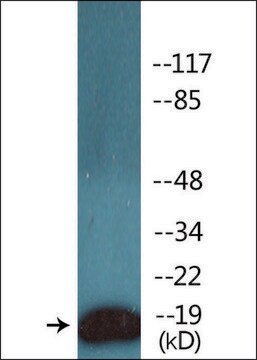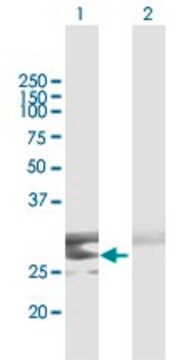ABE2626M
Anti-PASD1
from rabbit
Synonyme(s) :
Circadian clock protein PASD1, Cancer/testis antigen 63, CT63, OX-TES 11, PAS domain-containing protein 1
About This Item
Produits recommandés
Source biologique
rabbit
Niveau de qualité
Forme d'anticorps
affinity isolated antibody
Type de produit anticorps
primary antibodies
Clone
polyclonal
Espèces réactives
human
Conditionnement
antibody small pack of 25 μg
Technique(s)
immunoprecipitation (IP): suitable
western blot: suitable
Isotype
IgG
Numéro d'accès NCBI
Numéro d'accès UniProt
Modification post-traductionnelle de la cible
unmodified
Informations sur le gène
human ... PASD1(139135)
Description générale
Spécificité
Immunogène
Application
Epigenetics & Nuclear Function
Immunoprecipitation Analysis: 5 ug from a representative lot immunoprecipitated PASD1 in 500 µg of SW480 lysate.
Western Blotting Analysis: A representative lot detected PASD1 in HEK293T transfected myc-his Tagged PASD1 lysate V2 isoform (Courtesy of Dr Carrie Partch at University of California Santa Cruz).
Immunoprecipitation Analysis: A representative lot detected PASD1 in H1299 & SW480 cells (Courtesy of Dr Carrie Partch at University of California Santa Cruz).
Immunoprecipitation Analysis: A representative lot detected PASD1 in H1299 and SW480 cell lysates (Michael, A.K., et. al. (2015). Mol Cell. 58(5):743-54).
Qualité
Western Blotting Analysis: 0.2 µg/mL of this antibody detected PASD1 in lysate from HEK293T cells transfected myc-His Tagged PASD1, isoform 1, version2.
Description de la cible
Forme physique
Stockage et stabilité
Autres remarques
Clause de non-responsabilité
Vous ne trouvez pas le bon produit ?
Essayez notre Outil de sélection de produits.
Code de la classe de stockage
12 - Non Combustible Liquids
Classe de danger pour l'eau (WGK)
WGK 1
Point d'éclair (°F)
Not applicable
Point d'éclair (°C)
Not applicable
Certificats d'analyse (COA)
Recherchez un Certificats d'analyse (COA) en saisissant le numéro de lot du produit. Les numéros de lot figurent sur l'étiquette du produit après les mots "Lot" ou "Batch".
Déjà en possession de ce produit ?
Retrouvez la documentation relative aux produits que vous avez récemment achetés dans la Bibliothèque de documents.
Notre équipe de scientifiques dispose d'une expérience dans tous les secteurs de la recherche, notamment en sciences de la vie, science des matériaux, synthèse chimique, chromatographie, analyse et dans de nombreux autres domaines..
Contacter notre Service technique








